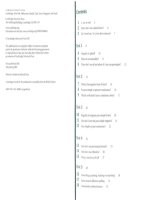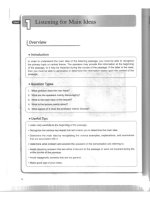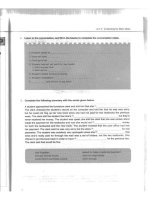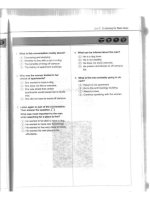How to grab them by the E.A.R? – improving students’ motivation in listening classes
Bạn đang xem bản rút gọn của tài liệu. Xem và tải ngay bản đầy đủ của tài liệu tại đây (1.27 MB, 13 trang )
TRƯỜNG ĐẠI HỌC SƯ PHẠM TP HỒ CHÍ MINH
TẠP CHÍ KHOA HỌC
HO CHI MINH CITY UNIVERSITY OF EDUCATION
JOURNAL OF SCIENCE
KHOA HỌC GIÁO DỤC
EDUCATION SCIENCE
ISSN:
1859-3100 Tập 16, Số 8 (2019): 203-215
Vol. 16, No. 8 (2019): 203-215
Email: ; Website:
Research Article
HOW TO GRAB THEM BY THE E.A.R?+
– IMPROVING STUDENTS’ MOTIVATION IN LISTENING CLASSES
Nguyen Le Bao Ngoc, Tran Doan Thu*
*
Ho Chi Minh City International University
Corresponding author: Nguyen Le Bao Ngoc – Email:
Received: April 08, 2019; Revised: June 25, 2019; Accepted: July 11, 2019
ABSTRACT
In mixed-level English classes, the differences in students’ proficiency pose huge challenges
for teachers. Surveys at intensive listening classes at International University show that over 40%
of the students require multiple times of listening. Meanwhile, the rest find 1 or 2 times sufficient
and thus feel demotivated with every repetition of the listening passage. To increase students’
motivation for the third time of listening, we propose a strategy called E.A.R: Extension and
Rewards. 130 students participate in this mixed-method research. The research shows E.A.R has
positive results and can also be applied in other skill classes.
Keywords: extension, listening, motivation, rewards, tiered activities.
Enhancing students’ motivation is our main focus in this research. We do believe that
teachers play a vital role in strengthening their students’ motivation. Moreover, we cannot
ignore the fact that teachers are also responsible when the highly motivated students begin
to feel bored in the class. “Whatever level of motivation your students bring to the
classroom will be transformed, for better or worse, by what happens in that classroom.”
(David, 1993, p. 193)
1.
Motivation
Before further discussion in this aspect, it is necessary to define motivation.
Motivation is defined as “the reason why somebody does something or behaves in a
particular way” (Oxford dictionary). In other words, motivation is the driving force that
enables people to continue and achieve their goals in whatever they choose to do. That a 6year-old boy manages to wake up early in the morning to go to school despite his laziness
Cite this article as: Nguyen Le Bao Ngoc, & Tran Doan Thu (2019). How to grab them by the E.A.R? –
Improving students’ motivation in listening classes. Ho Chi Minh City University of Education Journal of
Science, 16(8), 203-215.
203
Tạp chí Khoa học Trường ĐHSP TPHCM
Tập 16, Số 8 (2019): 203-215
requires some certain amount of motivation. This can be because of his mother’s promise
to give him an ice-cream cone as a reward. This can also be due to his own willingness to
go to school for knowledge. These different reasons give rise to the classification of two
types of motivation: extrinsic and intrinsic motivation.
1.1. Extrinsic motivation
Extrinsic motivation comes from outside factors such as the feelings and attitudes of
family, friends and society. Some certain rewards or punishment can also affect a person’s
desire to do something. In the context of education, extrinsic motivation is the motivation
that students have from outside the classroom. (Harmer, 2017). An example of this is a
high school male student manages to study hard and pass the university entrance exam to
receive an expensive gift – a new motorbike – from his parents.
1.2. Intrinsic motivation
Intrinsic motivation has been the centre of study by social and educational
psychologists for half a century (Tohidi & Jabbari, 2011). Intrinsic motivation comes
mainly from inside a person’s own will, when the driving force for performing an activity
is mainly because of happiness and enjoyment. At schools, intrinsic motivation can be
triggered mainly by what the teacher does in the classroom. More specifically, it is the
teaching method, classroom activities, and students’ self-awareness of success and failure
that can generate intrinsic motivation (Hammer, 2017).
2.
Literature review
While it is difficult to find ways for increasing students’ extrinsic and intrinsic
motivation, it is even more challenging to sustain it during the course. There are a variety
of reasons for students to lose motivation. One of those factors is mixed-level classrooms.
In mixed-level classrooms, students come from different age groups, family backgrounds
and most importantly, different academic levels. To solve this problem, numerous research
studies have been done. Maddalena proposed using high level students to work as teaching
assistants (TAs) in a mixed-level class (Maddalena, 2002). The result is that the majority of
students felt highly motivated and agreed that the TAs play a valuable role in assisting the
low-level students in the class. In 2015, a group of researchers proposed that scaffolding
could be of great help in multilevel classrooms. In construction, scaffolding refers to the
metal structures which are set up against the building to help builders reach to high places.
Likewise, in education, scaffolding describes support that teachers make and adjust
according to students’ needs (Pol et al., 2015). The result is positive but its tremendous
limitation is time constraint for both teachers and students involved.
Despite numerous ways of dealing with mixed-level classes, the most widely used
method is differentiating instructions in the classroom or tiered activities. The first research
204
Tạp chí Khoa học Trường ĐHSP TPHCM
Nguyen Le Bao Ngoc et al.
that came up with this term is Tomlinson (1999). She proposed the first ideas of
differentiating instruction to tailor students’ specific needs.
In 2001, Heacox wrote a book with templates and ideas drawn from Bloom’s
taxonomy and Gardner’s multiple intelligences to suggest different ways to tier activities.
Tiered activities mean designing different materials for students in different groups of
levels. This method of teaching ensures that teachers can meet the needs of all students and
thus increase and maintain students’ motivation. Richard & Omdal conducted a research
with 7 control classrooms receiving the same instructions and 7 treatment classrooms
receiving three levels of tiered instructions. They witnessed a clear difference in the
achievement of the low-level students who did not receive special treatment and those who
received tiered instruction (2007).
3.
Aim and purpose of research
While tiered instructions yield positive results, there is a lingering problem that must
be considered: students are divided into groups based on their level differences, which
results in discrimination. For students in low-level groups, they may feel intimidated and
inferior. On the other hand, students in high-level groups may find the other groups a
sizable hindrance in the lesson development. This can greatly affect students’ motivation.
Furthermore, the students in each group may have no motivation to change their class
status. They may simply accept their position in their labelled groups or feel satisfied with
the instructions designed specifically for their levels. Realizing this problem, we propose a
method that can aim at dealing with mixed-level classes but at the same time creating less
discrimination among students: Extension and Rewards (E.A.R).
This research aims at using E.A.R to deal with students from different level groups.
The research questions for this study are:
(1) Will students feel more motivated both intrinsically and extrinsically?
(2) Will this method benefit both the low-level students and high-level students in
class?
(3) Is the problem of discrimination solved by using E.A.R?
We also expect that this method, with less discrimination in the classroom, will enable the
low-level students to try harder and harness their skills rather than accept that they are only
in the low-level group. The high-level students will also benefit from the extension
activities and feel happier during the course.
4.
Definition, Procedures, and Materials
4.1. Definition
205
Tạp chí Khoa học Trường ĐHSP TPHCM
Tập 16, Số 8 (2019): 203-215
4.1.1. Extension
Extension is an activity on the same materials designed for students who complete
their required tasks: (1) well ahead of the allotted time (for Reading) or (2) before reaching
the maximum allowed attempts (for Listening).
4.1.1. Rewards
Rewards are bonus marks given to encourage students who accomplish the extension
activities successfully.
4.2. Procedures
The actual process of handling extension activities in the classroom can be broken
down into the following steps:
4.2.1. Without rewards (Weeks 3-6)
Teacher (T) conducts warm-up activities + introduces the topic of the lesson
teaches new vocabulary delivers the extension activities and explains the tasks in the
textbook requires students to listen and finish the tasks in the textbook before moving
on to the extension activities play the audio file 3 times corrects the textbook
activities and the extension activities.
4.2.2. With rewards (Weeks 7 - 8)
The process above is kept the same, but this time, teacher gives bonuses to students
who have correct answers for both the extension activities and the exercises in the
textbook.
After the midterm, both procedures are repeated, with four more weeks without
rewards and the last two weeks with rewards.
4.3. Materials
In International University, the textbooks for IE1 listening classes are Northstar 1:
Listening and Speaking (3rd edition) and Northstar 2: Listening and Speaking (4th edition).
The extension activities are designed with the same listening script as in the
textbooks. This guarantees that students will listen to the same audio file for both the
textbook’s tasks and the extra tasks. The students who finish the tasks in the books will
move on to the extra materials while those of lower level should continue to listen to the
tape and complete the textbook exercises. Below is one example taken from listening 1,
unit 6, Northstar 1: Listening and Speaking (3rd edition), pages 139-140 (Figure 1).
206
Tạp chí Khoa học Trường ĐHSP TPHCM
Nguyen Le Bao Ngoc et al.
.
Figure 1. Listening 1, Unit 6, Northstar 1
This task only checks for detail comprehension. It is worth mentioning that the
listening is preceded by a short reading passage which provides a background story for the
lesson, which makes it quite easy to predict the correct answer for all the questions in the
book. Thus, more than half of the students need only two times to finish the two tasks (see
Figure 3). Still, a high percentage of students require three times or more than three times
of listening. In the third time of listening, we encourage students who already finish the
two tasks in this unit to move on to the extra tasks in the handout. Below is an example
extension activity for Unit 6 mentioned above (Figure 2).
207
Tạp chí Khoa học Trường ĐHSP TPHCM
Tập 16, Số 8 (2019): 203-215
UNIT 6: RISK AND CHALLENGE
Listening 1:
Listen to two sports reporters talking about Diana Nyad on the radio. Complete the
summary using ONE WORD AND/OR A NUMBER for each blank.
Two sports reporters are talking about Diana Nyad. They are doing it from a (1) _______ in a
place between Cuba and Key West. The reason is Diana is making effort for the 4th time to swim
from Cuba to Florida. She has been swimming for (2) _______ hours and the weather is not very
good. The wind makes Diana swim much longer to get to Florida. Also, jellyfish bites all over her
body. She is swimming slowly and her body is (3) _______. Normally, a swimmer would give up
after being bitten by jellyfish. But Diana is not giving up. From Diana’s point of view, long
distance swimming is the “(4) _______ sport in the world”. It is also a boring sport since she has
to move her body the same way again and again during such a long time. In order to do that, Diana
has to(5) _______ not only her body but also her mind. In fact, she does a kind of meditation.
While swimming, she counts from 1 to 1000 in 4 different languages: English, French, Spanish
and German. She also sings. Diana also says that long distance swimming “is not a young person’s
game”. Diana has no fear even when there are (6) _______ in this ocean. This is also amazing that
she is now 62 but she still wants to set a new long-distance swimming (7) _______ for the 4th
time. She wants to show people, especially the old people, that it’s never too late to have a (8)
_______.
Figure 2. Sample extension activity for Listening 1, Unit 6, Northstar 1
We call this practice: the Extension. Students will listen to the same audio for
listening 1 in the book, but they have an extra task to do. This task is more demanding in
the way that students must synthesize all the information to complete the summary.
5.
Research method
5.1. Participants
This research population is 130 first-year students from IE1 Listening classes at
International University. The timescale for this research is from September 16th to
December 30th, 2018.
The students are placed in IE1 levels based on their scores in the placement test.
(TOEFL iBT-oriented test). The maximum score is 120. Those who score 0-35 will be put
into level IE1. This leads to a considerable gap in their English proficiency.
208
Tạp chí Khoa học Trường ĐHSP TPHCM
Nguyen Le Bao Ngoc et al.
5.2. Data collection
The data is collected via questionnaires which are delivered in the beginning, middle
and final stages of the course (at weeks 3, 8, and 14, respectively.) Written feedback is also
carried out at the end of the course.
The questionnaires are written in English, but there is explanation accompanying the
distribution. This is to ensure that all the students can interpret the questions in the same
way. There is also an online version of the questionnaire (Monkey Survey). The
questionnaires are all anonymous.
6.
Results
The return rates for the questionnaires are 78%, 98%, and 65%, in that same order.
The first half of Questionnaire 2 is a repetition of Questionnaire 1, and the first half of
Questionnaire 3 replicates the later half of Questionnaire 2. The purpose is to check the
consistency of students’ opinions. Although the response rates differ quite greatly, it is
clear that the distribution of their answer choices follow the same pattern throughout.
Below are Figures 3-8 which compare the results of each question between the two
questionnaires.
90
78
80
70
Questionnaire 1
60
Questionnaire 2
53
50
36
40
29
30
16
20
10
4
7
6
0
1 time
2 times
3 times
>3 times
Figure 3. How many times of listening do you need for each practice?
It is clear to see that for both questionnaires, the majority of students (51.9 % for
Questionnaire 1 and 61.4% for Questionnaire 2) state that they need an average of two
times of listening. The second largest group is those who need three times of listening
(28.4% and 28.3%).
209
Tạp chí Khoa học Trường ĐHSP TPHCM
80
Tập 16, Số 8 (2019): 203-215
68
70
75
60
Questionnaire 1
50
Questionnaire 2
35
40
25
30
20
10
6
4
2
10
3
1
0
Very easy
Quite easy
Average
Quite difficult
Very difficult
Figure 4. How do you judge the level of difficulty of the listening tasks in Northstar 1?
The distribution of students’ answer choices follows the same pattern in both
questionnaires, which suggests that the materials in the textbook are not very challenging
to the majority of students.
80
70
60
50
40
30
20
10
0
67 70
Questionnaire 1
Questionnaire 2
37
18
4
10 13
3
Disappointed
Bored
Neutral
Interested
3
4
Excited
Figure 5. How do you feel when you have to listen to the passage for the third time?
For the three largest groups, the patterns are the same for both questionnaires. The
patterns are reversed for “disappointed” and “excited”, but the difference is too small (1) to
take any real notice.
60
Questionnaire 2
50
45
50
Questionnaire 3
40
30
10
26
Poly. (Questionnaire
2)
20
2
41
20
16
10
Poly. (Questionnaire
3)
2
0
0
Disappointed
Bored
Neutral
Interested
Excited
Figure 6. How do you feel when the teacher designs extra activities for the third listening time?
210
Tạp chí Khoa học Trường ĐHSP TPHCM
Nguyen Le Bao Ngoc et al.
Questionnaire 2 shows that the most common type of feelings for the extension
activities is “neutral” (39%). However, the general impression of the students is heavily on
the positive side - “interested” and “excited” (51%), more than 5 times of the negative side.
Meanwhile, questionnaire 3 reveals that there is a great shift towards the positive
side. To be specific, “neutral” comes down to third position, falling from 39% to 18.8%.
That discrepancy of 21% shifts to “interested” and “excited”.
60
49
50
41
35
40
27
30
20
10
46
9
3
2
0
Disappointed
Bored
Neutral
Interested
Excited
Questionnaire 2
Questionnaire 3
Poly. (Questionnaire 2)
Poly. (Questionnaire 3)
Figure 7. How do you feel about the bonus marks given for the extra activities?
The general trends in both Questionnaires are nearly the same, with the majority of
students feel “interested” and “excited” (74,7% for Questionnaire 1 and 89.3% for
Questionnaire 3). This again shows high unity in their answers.
57
60
47
50
39
40
30
37
22
20
10
9
0
1
0
0
0
Disappointed
Bored
Neutral
Interested
Excited
Questionnaire 2
Questionnaire 3
Poly. (Questionnaire 2)
Poly. (Questionnaire 3)
Figure 8. How do you feel about this listening class (with extra activities and bonus marks?)
211
Tạp chí Khoa học Trường ĐHSP TPHCM
Tập 16, Số 8 (2019): 203-215
The answers for this question in both questionnaires show great consistency with
similar rising patterns.
For the written feedback, students are required to describe their feelings. Various
expressions are used to depict their feelings, but the answers can be classified into 5
groups. The majority of the participants (83.5%) claim that they have an enjoyable
experience in their listening classes, using terms such as “excited”, “interested”, “happy”,
“wonderful”, “fun”, “attracted”, “great”, “satisfying”, etc., and thus can be categorized into
the group “Happy”. Three of them feel the classes are “alright” or “OK”. The same number
of students are not quite sure of their feelings, because they state that sometimes “I feel
bored”, but other times “I am happy.” One student gives a negative answer to this question,
attributing the reason to the lack of chances for him/her to earn bonus points because
he/she is not as good at listening as other students who are quicker in submitting the
answers to the teacher. Seven students choose not to give an answer.
Table 1. Results of question 5 of questionnaire 3
Question 5: What can be done to make this listening class more exciting?
No answer
37
More bonus marks
11
More music or films/ videos
11
More games
9
More extra activities
8
No change
7
More discussion
2
Change textbook
2
More homework
1
More discussion
1
More teamwork
1
More tips for listening practice
1
More role plays
1
More students chosen for bonus marks
1
7.
Discussion
As can be seen from Figure 5, most students did not feel very motivated when they
had to listen to the passage in the textbook for the third time. However, reducing the
number of listening time to two times was not an option, because the number of students
who needed three times of listening or more still account for a large part. Therefore,
extension activities and rewards came in as a solution to this problem.
There is a phenomenon that less students find it necessary to listen to the files more
than 3 times in questionnaire 2 - week 8 (see Figure 3). The possible reason could be that a
part of the students who had difficulty in listening at first were more accustomed to the
212
Tạp chí Khoa học Trường ĐHSP TPHCM
Nguyen Le Bao Ngoc et al.
listening tasks in the textbook, and therefore, got a grasp of the tasks and needed less times
of listening. As notable as it may be, this phenomenon actually reassures our aims and
purposes of research - that most students do not need a third time of listening, but they
have to, and they need something else for them to do during the third time of listening.
Another point worth noticing is that students seemed to respond more
enthusiastically towards rewards, which is a form of extrinsic motivation, than towards
extension activities, which is a more of a form of intrinsic motivation. This is certainly
justifiable, as external rewards can stimulate interest and participation in which person has
not had initial interest (Cherry, 2016).
Only one student gave a negative answer when being asked about his general
feelings towards the listening class (see Figure 8). The reason he gave for his opinion is
because his listening skills were so poor that he could never get a chance to finish the
extension activities and submit his answer to get bonus marks. He also complained that the
number of students chosen for bonus marks was very limited (5 students) and he wished
there were more slots. Interestingly, though his answer was “No”, he actually thought that
the extension activities and the bonus marks made the class more interesting. From this, we
realize there are still some limitations in our procedures. Though the extension activities
and bonus marks did blow some fresh air into our classes, there were still special students
who we could not fully motivate.
The fact that students asked for more extension activities (fourth-ranking) and bonus
marks (first-ranking) (see Table 1) speaks a great deal about our action research. It means
that we were on the right track of motivating them, and that we should do more. Moreover,
when taking the second and third-ranking suggestions (movies, music, and games) into
consideration, we could not help thinking of new forms of extension activities. For
example, we can turn the listening scripts into songs or we can let students act out and
record video footage of those listening scripts. It would be interesting to see how the
students respond to those activities, which opens the door for future research.
Finally, more students had positive feelings towards the extension activities in the
second half of the course rather than in the first half (see Figure 6) can be attributed to the
gradual building of their intrinsic motivation. They soon learned that the number of
students who could get bonus marks is quite small (5 for each meeting), and yet, they still
thought that the extension activities were interesting, even exciting. This can be evidence
that they completed the extension for the sheer joy of learning.
8.
Conclusion
This paper examines the role of E.A.R in enhancing students’ intrinsic and extrinsic
motivation in IE1 listening classes. The research has been successfully carried out thanks
to great contributions from students and lecturers from 5 different IE1 classes. The results
reveal that there is a strong correlation between E.A.R and students’ motivation. We also
213
Tạp chí Khoa học Trường ĐHSP TPHCM
Tập 16, Số 8 (2019): 203-215
find out that this method, with less discrimination in the classroom, enables the low-level
students to try harder and get advanced with their listening skills. The high-level students,
from feeling bored with the materials, now feel more motivated. The researchers of this
paper also create a by-product: a collection of extension activities for 2 coursebooks
(Northstar 1: Listening and Speaking & Northstar 2: Listening and Speaking). All teachers
who use these two books in their courses can use this collection as a reference.
Furthermore, E.A.R can also be used in other class types. Firstly, this research suggests
another approach for teachers in all types of reading and listening classes. Secondly, E.A.R
can be applied in other subjects such as Math, Physics, etc. Last but not least, when
students are highly motivated in the class, teachers are also happier. Further studies on the
topic may include teachers’ interview to see if E.A.R can actually enhance teachers’
motivation.
Conflict of Interest: Authors have no conflict of interest to declare.
REFERENCES
Cherry, K. (2018, October 18). Extrinsic vs. Intrinsic Motivation: What's the Difference? Retrieved
from
/>David, B. G. (1993). Tools for teaching. San Francisco, CA: Jossey-Bass.
Frazier, L. L., & Mills, R. (n.d.). Northstar 2: Listening and Speaking (4th ed.). Pearson Education
ESL.
Heacox, D. (2001). Differentiating instruction in the regular classroom: How to reach and teach
all learners, Grades: 3-12. Minneapolis, MN: Free Spirit Pub.
Maddalena, S. (2002). Using high level students as teaching assistants in a mixed-ability
classroom. Teaching English as a Second or Foreign Language, 6(1).
Merdinger, P., & Barton, L. (2015). Northstar 1: Listening and speaking (3rd ed.). Pearson
Education ESL.
Pol, J. V., Volman, M., Oort, F., & Beishuizen, J. (2015, June 5). The effects of scaffolding in the
classroom: Support contingency and student independent working time in relation to student
achievement, task effort and appreciation of support. Springer, 43, 615-641.
doi:10.1007/s11251-015-9351-z
Richards, M., & Omdal, S. N. (2007, May 1). Effects of tiered instruction on academic
performance in a secondary science course. Journal of Advanced Academics, 18(3), 424-453.
Tohidi, H., & Jabbari, M. M. (2012). The effects of motivation in education. Procedia -Social and
Behavioral Sciences, 31, 820-824.
Tomlinson, C. A. (1999). The differentiated classroom: Responding to the needs of all learners.
Alexandria, VA: Association for Supervision and Curriculum Development.
214
Tạp chí Khoa học Trường ĐHSP TPHCM
Nguyen Le Bao Ngoc et al.
LÀM SAO ĐỂ CẢI THIỆN ĐỘNG LỰC HỌC TẬP CỦA SINH VIÊN
TRONG MÔN NGHE BẰNG PHƯƠNG PHÁP E.A.R?
Nguyễn Lê Bảo Ngọc, Trần Đoan Thư*
Trường Đại học Quốc tế – ĐHQG TPHCM
Tác giả liên hệ: Nguyễn Lê Bảo Ngọc – Email:
Ngày nhận bài: 08-4-2019; ngày nhận bài sửa: 15-6-2019; ngày duyệt đăng: 11-7-2019
*
TÓM TẮT
Trong các lớp học tiếng Anh, sự khác biệt về trình độ của học viên thường là một thách thức
lớn với người dạy. Khảo sát thực hiện ở các lớp kĩ năng nghe tại Trường Đại học Quốc tế cho thấy
rằng trên 40% sinh viên cần nghe một bài nhiều lần. Trong khi đó, phần còn lại cho rằng chỉ cần
nghe 1 hoặc 2 lần là đủ và do đó sẽ cảm thấy giảm động lực khi phải nghe đi nghe lại. Để giải
quyết vấn đề này, chúng tôi đề xuất một phương pháp gọi là E.A.R: Extension and Rewards. 130
sinh viên tham dự vào nghiên cứu đa phương pháp này. Kết quả của phương pháp này cho thấy
sinh viên ở các cấp độ khác nhau đều cải thiện được kĩ năng nghe rõ rệt. Kết quả khảo sát cũng
cho thấy sinh viên hứng thú hơn nhiều với việc nghe một bài nhiều lần. Ngoài ra, phương pháp này
có thể áp dụng ở các lớp học kĩ năng khác.
Từ khóa: động lực, hoạt động phân tầng, môn nghe, phần mở rộng, phần thưởng.
215









